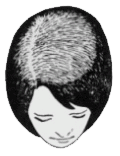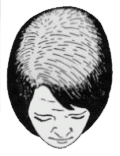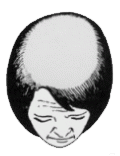Hair loss
It is normal to lose 50–100 hairs a day as part of the hair-renewal process. However, some people may suffer from excessive hair loss at certain periods of their life. Hereditary factors are the most common cause; other reasons include reactions to hormonal, chemical or nutritional factors, medical treatments, such as chemotherapy, thyroid disease, local or generalised skin disease and stress.
Please scroll
to discover more
Hair structure
Three-layered strand
A strand of hair is the visible part above the skin, while the deeper segment under the scalp is known as the root. Composed of three layers, each strand is roughly 70–100 microns in diameter.THE CUTICLE, the external layer of a strand of hair, is formed of hardened protective cells. It is without pigment and arranged much like the shingles on a roof, intertwined and overlapping. These thick cells collectively give hair its texture.THE CORTEX lies between the cuticle and medulla and is directly related to the hair’s volume. The fibrous cells of the cortex contain keratin (the principle ingredient in hair) and melanin (the pigment that gives hair its colour).THE MEDULLA is the innermost centre of a stand of hair, comprising 0–10% of its volume. In the case of very fine hair, the medulla is absent.THE ROOT is the living part of the hair, anchored in the scalp. At the tip of the root is a slightly larger area known as the bulb; when a hair is plucked, the bulb has a thick, whitish appearance.THE PAPILLA is the curved and empty area at the base of the bulb. It connects the hair to the head. Here, the blood vessels and nerves meet and the hair receives its nourishment.
The hair cycle
Cyclical growth
Depending on various factors, the quantity of hair varies from one person to another. It is estimated that the average person has between 100,000 and 150,000 hairs on the scalp. A hair cycle begins every two to six years and lasts three years on average. This cycle, which is genetically programmed, follows three stages.During the anagen phase, also known as the growth phase, the hair grows about 1cm per month. The anagen phase lasts between two and five years. The hair bulb secures itself within the skin, where it will remain until the resting phase.The catagen phase is a transitional phase that lasts about three weeks. This phase marks the end of the active formation of the hair and the bulb.The telogen phase, also known as the resting phase, occurs when the bulb reaches maturity. The keratin-filled bulb emerges from the papilla and surrounds itself with a chain of cells, called the epithelium-lined sac.
Female alopecia
Hair loss in three stages
About one-third of women experience hair loss at some point in their lives. After menopause, two-thirds of women go through some form of hair loss or thinning.The most common type of hair loss in both sexes is androgenetic alopecia, also known as male/female pattern hair loss. In women, androgenetic alopecia begins with gradual thinning at the parting, followed by increasing diffuse hair loss radiating from the top of the head.
1

2

3

-
1
Minimal thinning of the hair with a widening of the part line.
-
2
Noticeable widening of the mid-line part.
-
3
Diffuse hair loss on the top of the scalp.
1

2

3

4

5

-
1
Symmetrical hair loss in the temple frontal area.
-
2
Additional hair loss in the temple area and thinning of the hair at the crown of the head.
-
3
These two zones tend to move towards each other in the direction of the vertex.
-
4
Baldness has set in. The remaining hair forms a horseshoe shape around the baldness in the center of the scalp.
-
5
Hair loss on the sides of the head.
Male alopecia
Hair loss in five stages
Most men will experience a form of hair loss or thinning at some point in their lives. Such hair loss is usually gradual, but in some instances it may be sudden, due to a medical problem or an underlying condition.The most common type of hair loss in both sexes is androgenetic alopecia, also known as male/female pattern hair loss. In men, hair loss usually begins above the temples, and the receding hairline eventually forms a characteristic M shape; hair at the top of the head also thins, often progressing to baldness.

